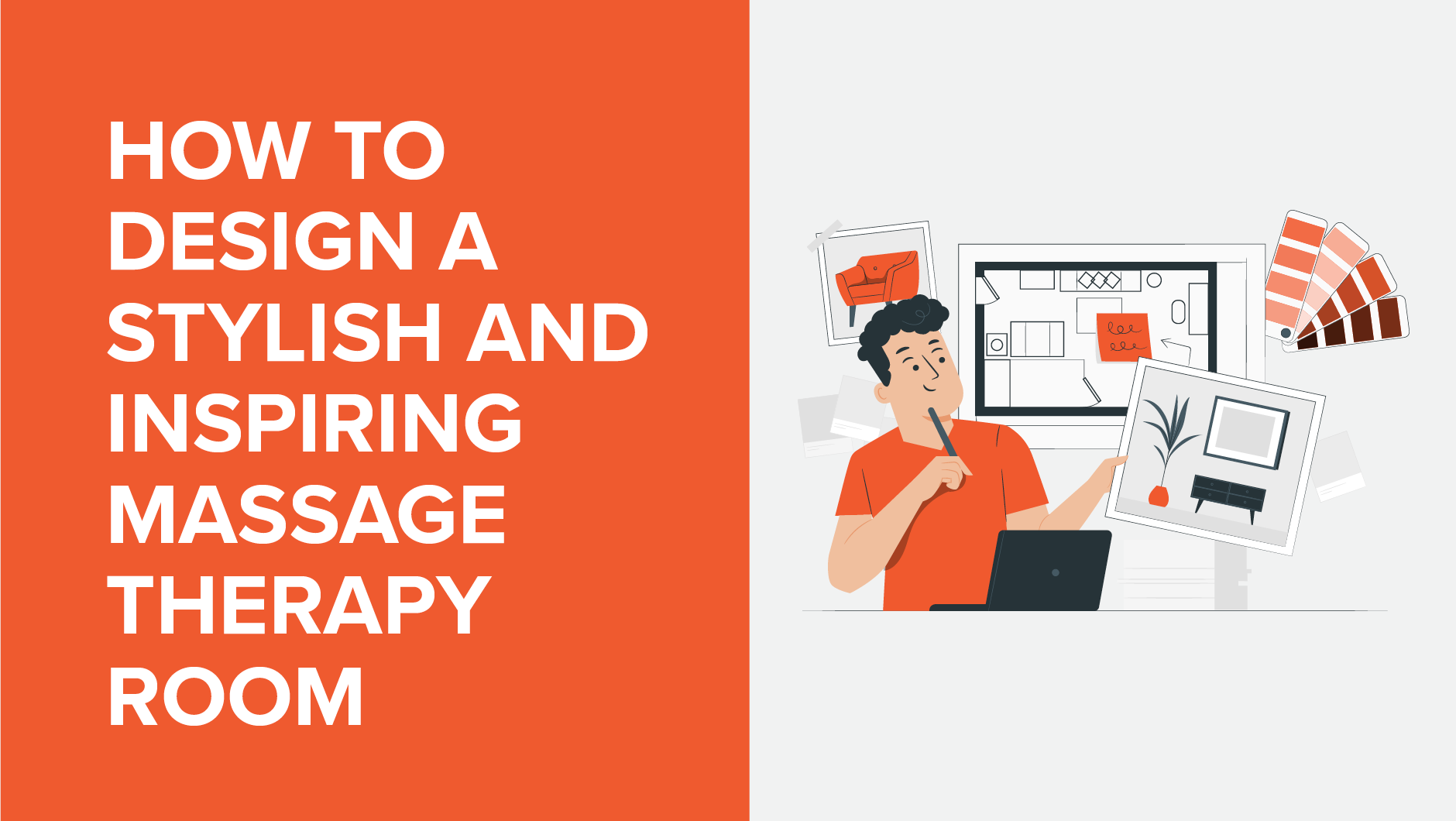Contents
Whether you are just in the planning stage or re-designing your massage room, this guide will discuss everything you need to know:
Every small detail counts, so focus on the sights, smells, and sounds a client encounters while enjoying a top-notch appointment with you. With the information you learn here, you’ll be able to create a beautiful space for your clients to relax—a place they’ll want to keep coming back to.
Designing a massage room: FAQs
How do you set up a massage therapy room?
Your massage table is the most important component of your massage room. That’s the centerpiece that you must build around. After purchasing your table, focus on stocking your room with necessary supplies and organizing them into storage solutions like cabinets.
Then, you can add design elements and decorations that create a calm, relaxing environment and provide the ambiance you desire. While you do this, ensure that your space is clean and organized. You don’t want clutter to distract your clients or to hinder your movement around the table.
What is the ideal size for a massage room?
A standard massage table measures 28 inches wide and 73 inches long. Ideally, a massage therapist should have three to four feet of space around their table to move around and use proper massage techniques. If you have a rolling cart for oils, linens, and other tools, the space around the massage table should also accommodate that. Your room should also be large enough to fit any storage solutions you’re using to keep any other equipment and tools organized.
Considering all those factors, your massage room should ideally be no smaller than 10 feet by 10 feet. However, a larger massage room gives you more space to work in, add storage to, and decorate.
How do I design my massage room?
Before you start looking at the elements of massage therapy room design, you need to decide on a few things:

- Budget: This represents how much you can invest in decorating your space. Ideally, it should be a sum large enough to make the room functional and pleasant to be in.
- Location: The flexibility you have for decorating will depend on where your practice is located and how large the space is. You can try to rent a commercial space, redesign a room in your house, or share an office with other massage therapists or bodyworkers.
- Business values: Define your business’s mission, vision, and values to fully understand how you want your clients to feel and how you want them to picture themselves interacting with your massage practice. You may have already done this when outlining your massage practice's business plan.
Once you’ve established these elements, you can proceed with designing your massage room. Choose a color palette and general theme for the room to keep all your elements harmonious. For instance, most massage therapists focus on relaxation. To that end, they might install storage cabinets in neutral or warm colors, add decorations reminiscent of forests or oceans, and add dimmers to their lighting.
Although it’s tempting to prioritize making your massage room aesthetically pleasing, remember that great massage room design is first and foremost functional. Consider how your design impacts your ability to provide stellar massages to your customers.
Massage room design elements
Now that you know the general guidelines for designing a massage room, let’s look at specific design elements you should incorporate.

Entrance
Never underestimate the power of a door and the allure of what’s behind it. This is how you set the tone of your massage therapy room design. Consider how you’ll bring people in—is there a front door? A separate entrance? What type of pathway leads up to it? Regardless of your choice, your entrance should be clean and welcoming so patients feel at ease entering your practice.
Walls
With walls, less is more. They dictate a room’s balance by acting as a backdrop for all other elements. Though you have many options for the style of your walls (including wallpaper or paint), consider the combination of patterns and textures in the room first—you don’t want it to look too busy or distracting.
In terms of the best colors to use for walls, the general consensus is that cool and neutral tones are the most calming to the nervous system. Soft blues, greens, whites, and beiges give a sense of calmness, making them the perfect choice for a peaceful massage room.
Flooring
Floor coverings significantly impact a room's style, so choose a finish that is not just stylish but safe and long-lasting. Remember that it must withstand years of foot traffic, be free of harmful toxins, and have a design that stays in style.
The best flooring options include vinyl tiles, wood, or cushioned recreational surfaces. Avoid marble, granite, or any tile too hard for you to stand on for long periods. If the floor is plain cement, try painting it or adding a carpet that matches the walls. Monochromatic schemes and unbroken lines make a room look bigger than it actually is and create a harmonious environment.
Lighting and ceiling
During a massage session, clients will be face down toward the floor or face up at the ceiling, so put time and thought into decorating these areas of your massage room. In particular, lighting is one of the best ways for a massage therapist to create a warm, inviting ambiance in their room.
Since clients may be lying face up, relying on an overhead light for illumination is not advised. Plus, overhead lights often make rooms look harsh or sterile. Instead, explore different light setups that distribute the brightness in your massage room evenly. Use ceiling and wall lighting and a mix of mid- and low-level illumination, such as candles, fairy lights, and Himalayan salt lamps.
Additionally, smart lighting that can be dimmed and adjusted through a smartphone app allows you to customize the ambiance for each customer. Certain options even have color-changing modes to truly personalize and transform your space into a tranquil haven.
Massage table
Take special care with your massage table, the main attraction of your practice. Given the relatively small space in most massage rooms, you don’t typically have much of a choice where the table goes. However, based on the basics of Feng Shui, there’s one position to avoid: the coffin position.
According to Feng Shui experts, a bed should never directly face the door, with either the feet or head pointing toward it. This is because many Asian countries use this position to carry out their dead. It also places the person on the bed in line with all the forces and energies that might enter the bedroom, which may cause stress or worry. For a massage practice that aims to relax its customers, it’s better to avoid this position.
Items and equipment
As a massage therapist, you need items and equipment to practice your craft, which means that you’ll need them in your massage room. Here are a few examples of items you’ll need:
- Face cradle and arm rests
- Bolsters and support pillows
- Sheets and blankets
- Towels and washcloths
- Oils, lotions, and creams
- Hot stones or hot packs
- Cupping sets or gua sha scrapers
- Sanitizing spray or wipes
- Aromatherapy diffuser
- Trash can
If you offer any specialty services, you may need additional items to properly implement your massage technique.
Furniture and storage
Simplicity goes a long way when setting up your massage therapy room’s furniture, storage, and equipment. When buying these items, don’t forget your clients’ needs. Make sure to:
- Create a changing area for clients that is private and comfortable.
- Add shelving or storage spaces for clients to leave their personal belongings for the duration of the massage.
- Hang up a nice mirror so your clients can fix their hair, clothes, and makeup before leaving.
Additionally, since you’ll be storing many items and supplies in your massage room, incorporate solutions like cabinets and drawers to keep everything organized. Ideally, the cabinets or drawers should be easily accessible.
Some massage therapists use rolling massage carts, which they stock with items needed for the specific massage they’re performing. Once the session is over, they can swap out items for their next appointment.
Decorations
Your style and personality should be reflected in your massage therapy room’s design, specifically in your decor. Consider starting by establishing an overall feel to the room, such as an ocean or forest theme. Then, add paintings, plants, tapestries, candles, and small trinkets without overdoing it. You can also incorporate small flairs to improve relaxation like small water fountains or a tabletop zen garden.
Whatever combination of decor you choose, keep it simple and don’t overdo it. Simplicity and functionality are your goals. You don’t want your clients to feel claustrophobic, and you’ll want plenty of space to move around during sessions. And, with a well-decorated space, you’ll feel empowered to post pictures of your massage room on your Instagram and other social media pages to boost interest in your practice.
Massage room design tips

Declutter and organize
When it comes to creating a relaxing space, less is more. However, that doesn’t mean scrimping on supplies and other necessities. You just need to establish a sound storage system and make every corner of the room functional.
For example, well-designed boxes can serve as both storage and décor. A curtain or divider can hide the view of stocks and supplies from the massage room.
As Feng Shui experts put it, too many elements in a room can be overwhelming, and clutter and debris obstruct the flow of chi or good luck. Always keep your massage room clean and organized to create a harmonious and fresh space for customers to relax in.
Comfort is Crucial
Aside from being pleasant to be in and having a relaxing ambiance, your room should also be comfortable for your clients. Here are a few ways you can make the massage experience more comfortable:

- Massage table. Always check your massage table for rough spots and sharp edges that may impede your client’s enjoyment, and invest in a good massage table with thick, high-quality foam.
- Temperature. Adjust the temperature to the client’s preferences—every client is different and will have different tolerances to cold and heat.
- Music. Some clients may prefer silence and no music at all, while others love listening to ambient or natural sounds.
- Talking. Some clients like to chat during their session, and others prefer to completely tune out once the massage commences. The rule of thumb here is if they’re not talking to you, then don’t talk to them.
If you’re unsure what your clients would like, don’t hesitate to ask them directly! Most clients appreciate when their massage therapist asks for their preferences to provide a better experience. Plus, knowing and adhering to these preferences will help you build lasting client relationships.
Design with your brand in mind
When you’re first starting your massage practice, your massage room might contain just the bare essentials, such as your table and supplies. As your practice grows and you secure more regular customers, you can focus more on delivering a massage room design that relaxes clients and keeps them coming back.
As you rework your design, keep your business’s brand in mind. Just as you would deliver consistent branding across all your marketing materials, you want your massage room to reinforce your existing branding, not clash with it.
For example, let’s say your brand colors are mainly blue or cool-toned. To avoid overwhelming your clients with color, you can design your massage room with an ocean theme to incorporate your brand colors in a soothing way.
This means you might have furniture in a light neutral color and add pops of blues, such as blue pillowcases, flowers, crystals, or even curtains. You might also choose to add abstract art or ocean pictures on your walls.
Focus on delivering a consistent aesthetic that allows customers to immediately recognize that the space they’re in belongs to your business. Bonus points if your waiting room also follows the same design scheme!
Additional resources
The most important element in massage therapy room design is you, the massage therapist! At the end of the day, you create a beautiful ambient space that your massage clients will look forward to visiting. Your talent in massage and bodywork keeps your clients coming back for more. So have fun designing your massage room, and remember that you can always make changes to ensure the decor and design fit your business.
Want to learn more about running a massage practice? Check out these resources:
- 15 Well-Designed Massage Therapist Websites to Inspire Yours — Massage room design isn’t the only design you need to consider. Here are examples of great massage therapist websites to look through.
- Massage Therapy Marketing: 15 Effective Ideas to Explore — Getting the word out about your massage practice is essential to attracting new clients. Discover the most effective marketing ideas here.
- A Guide to Massage Billing: Insurance Codes for Therapists — Did you know that you can accept insurance at your massage practice? Read this guide for everything you need to know about the process.

.png)







